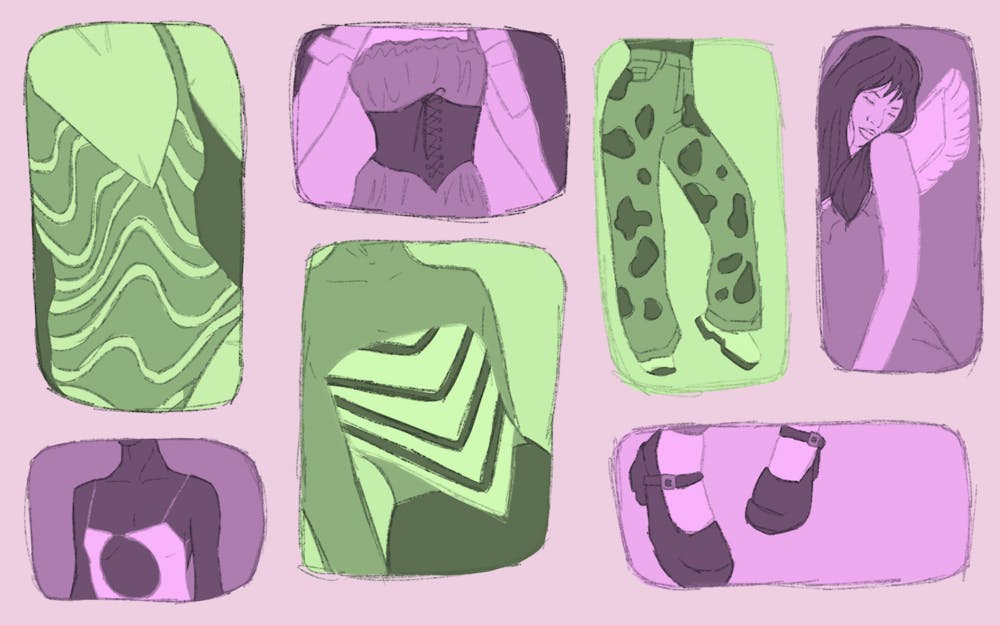About a year ago, House of Sunny, a British ready-to-wear brand, released a viral green dress. Midi style, swirly and seemingly knitwear, it took Instagram by storm. A month or so later, it became tacky. A new dress took its place. The too-quick cycle of fashion continues.
Before the rise of fast fashion companies like Zara and Shein, trend cycles lasted around ten years, allowing use of the garments before they went out of style. Now, with fast fashion being one of the more accessible ways to follow trends, the cycle lasts only a few months. This trend of overconsumption is horrific for our environment but also horrific for ourselves. Who are we apart from these trends?
Corporate greed can’t be the only thing to blame. The rise of social media – Pinterest, Instagram and TikTok in particular – has placed a larger emphasis on being popular and looking cool. Influencers can make or break the popularity of a garment. It is their job to embody what’s cool anyway. This practice also furthers the conciseness of trends. An influencer wears the clothes, their followers buy the clothes, the influencer stops wearing the clothes and then their followers throw the clothes out.
Obviously, this creates a huge problem for our environment. According to the Environmental Protection Agency, only 14.7% of all textile waste in 2018 was recycled. Consequently, 11.3 million tons of textiles were sent to the landfill in that same year.
How can we become more environmentally conscious? It’s simpler than one might think.
Stop following trends.
It’s hard to know what’s trendy in which spaces nowadays, with algorithmic marketing making one niche style seem like it’s what everyone is wearing. For example, the people on my TikTok “For You” page are all wearing early 2000s Juicy tracksuits or late ‘80s goth clothes. My sister, on the other hand, mostly sees statement pants and styling videos. Online spaces dictate most of what is popular now, not magazines or television like in decades prior.
There’s one term I’ve seen thrown around a lot without much context. It’s called personal style.
Personal style is dressing for oneself. It’s not about following trends or looking good to the public. It certainly can be, but it focuses on looking how a person wants to look. Personal style has been much more emphasized in the past ten years, and for good reason. It can be more environmentally friendly and actually boost your confidence. Influencers have gained larger platforms for looking different and quirky, my favorites being Clara Perlmutter, aka @tinyjewishgirl, and Sara Camposarcone, aka @sarahcampz, on TikTok.
These people are definitely outliers with their over-the-top fashion tastes, but they do have one thing in common. They wear their clothes. Being a chronic outfit repeater is never an issue with these two or people like them because it looks good. It’s different. And they like the way they look. The term “outfit repeater” has even been used as an insult in popular culture. It’s so odd to me that it is taboo to wear clothes often. You paid for the clothes, why not wear them?
On a more personal level, I’ve noticed it’s much easier for me to get dressed in the morning when I like all of the clothes I have in my closet. It’s not a concern to me to look good for other people. I dress for myself. Since I found what clothes I like to wear, I actually wear all of my clothes. I believe clothes are made to be worn until they fall apart, and I have definitely pushed those limits.
If looking good to you means being trendy, by all means, go for it. It’s most important to like the way you look. Take into consideration how often you will wear the clothes. Be better to the environment and to yourself.
Char Jones (they/her) is a sophomore studying English and journalism.






